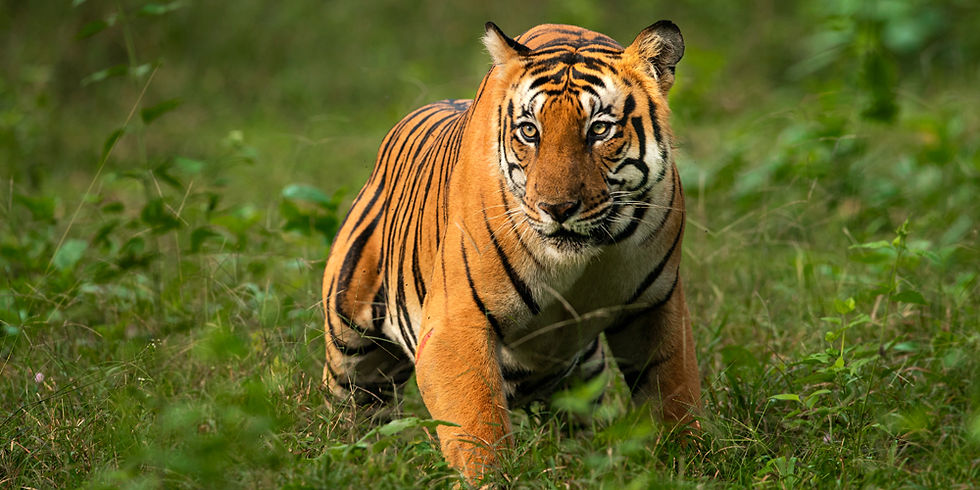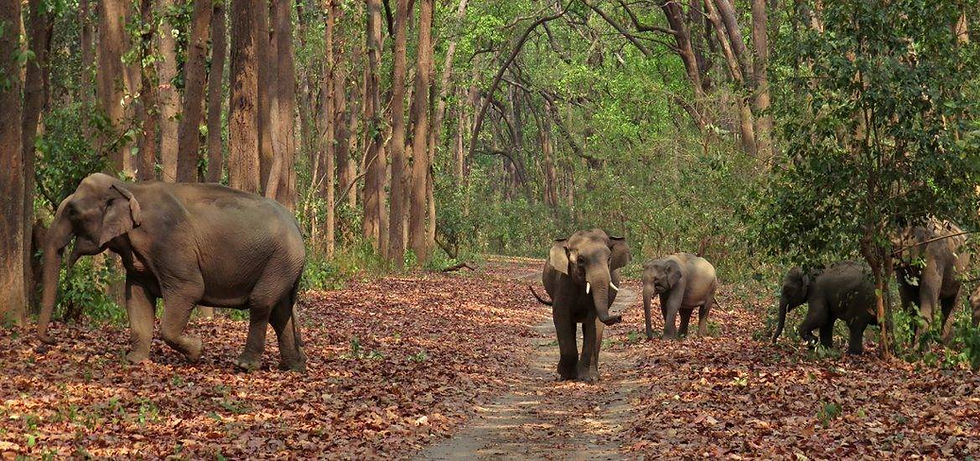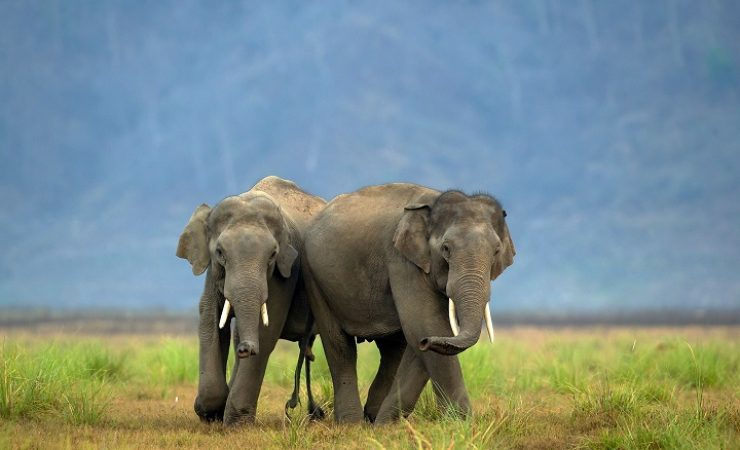
The state of Uttarakhand is home to the 1936-founded Jim Corbett National Park. Initially known as Hailey National Park, it was established with the goal of safeguarding the Bengal Tiger. Jim Corbett is a nice weekend getaway from Delhi. It just takes six hours to get to the forests from the city. Jim Corbett is a charming retreat with lush green scenery and a peaceful atmosphere away from city worries. Visitors can reach some areas of the park, but others are guarded and unaffected by intrusion from the outside world. If you like being in nature, this is a great place to go over the long weekend. Read this Jim Corbett travel guide to learn what surprises this national park has in store for you.
Jim Corbett National Park's Best Season to Visit
Due to the fact that Corbett has a temperate temperature, the national park is open throughout the year, with the exception of the monsoon season, during which time certain sections of the park are inaccessible to tourists. The months of November through February, which fall within the park's winter season, are ideal for going there because the temperature is usually very mild. In addition, it is not difficult to spot wild creatures in the jungle at this time of year. Because of the large number of different bird species that may be observed during this time, it is also the best time of year for people who enjoy going bird watching. Even if the summers are bearable, it's possible you won't encounter much wildlife due to the dense vegetation. Only in the region surrounding the pond are they ever spotted.
Jim Corbett National Park Attractions
The rush and bustle of the city can be left behind when one visits Jim Corbett for a relaxing break. It is a beautiful weekend retreat from Delhi that won't cost you more than five thousand. Learn more about the things you can do at this national park by reading this.
Jungle Safari

An excursion on a safari is the most enjoyable method to explore any national park. It is possible to go on safari in any one of the five different zones that make up Jim Corbett. There are five distinct zones in Jim Corbett National Park: the Dhela zone, the Bijrani zone, the Jhirna zone, and the Durgadevi zone. The Dhikala zone is the most remote. In this national park, visitors have the option of going on either a canter safari or a jeep safari in order to discover the surrounding forest and observe the various species of flora and fauna. It used to be possible to go on elephant safaris, but those excursions are no longer provided.
River Rafting

If you enjoy going to different locations, you will find that Corbett provides yet another exciting water activity. Rafting down the Kosi River is an activity that is highly recommended. This is a seasonal activity that is typically available from July through September when there has been some precipitation in each of those months. The activity is dependent on the rain and would not be viable during times of heavy precipitation because rafting becomes risky in these circumstances. The rain is necessary for this activity.
Camping

Camping is another exciting experience that you have the opportunity to partake in while visiting Jim Corbett National Park. It is not often that one gets the chance to camp out in the open air, among the trees, and under the stars. Therefore, going camping is a wonderful option at this time. Because it is such a positive learning experience, everyone ought to give it a shot at least once. It is utterly delightful, and it gives one the impression that they are becoming more connected to nature. There are both permanent and transitory campgrounds located inside the boundaries of Corbett. The ones that are intended for longer stays are in the form of cottages that are dispersed throughout the park. The Sitabani woodland is where you'll find the fleeting ones.
Bird Watching

National parks are like heaven on earth for anyone who is passionate about the natural environment and bird watching. There are around 650 distinct bird species in the Corbett region, some of which migrate all the way from Siberia to make their home in Corbett. The months of November and December are the greatest time to go to the national park in order to see these birds because that is when the park is at its busiest. The cinnamon bittern, the white pelican, and the black-headed night heron are just a few of the odd or rare species that can be observed in this area.
Trekking

One of the most exciting activities available in Jim Corbett is trekking, which provides visitors with the opportunity to explore the park on foot. If you like to spend your time outside, Jim Corbett would be an excellent choice for a vacation destination for you. It offers a variety of enjoyable activities to choose from. In addition to going on hikes, visitors here can also participate in other activities such as river rafting and rappelling. In this area, there is a network of hiking trails that can be explored, particularly in the protected areas of the park. The Sitabani Reserve is, without a doubt, the most desirable place to go hiking in this region. Remember to carry water with you on the hike, and make sure your shoes are comfortable.
The Stunning Wild Animal Sanctuary in Jim Corbett

Jim Corbett National Park was one of the first parks to be established in India. The park was established in 1936 and given the name Hailey's National Park at that time. The area is famous for its tigers, and the park has done its part to uphold the region's reputation by maintaining the richness of its ecosystem. Jim Corbett is a very exceptional and one-of-a-kind park because it is one of the few national parks that allows visitors to remain the night on its premises.
The landscape of the national park is quite diverse since it consists of areas of marshy soil, lakes, small hills, and beautiful meadows. Jim Corbett National Park is home to an exceptionally diverse collection of flora and fauna, the most famous of which are the park's namesake tigers. Jeeps are available for rent to visitors, who can then drive around in them while taking in the scenery.
Jim Corbett National Park Zones

The inclusion of these well-known locations is necessary for a tour guide to Jim Corbett to be considered comprehensive. The following is a breakdown of five regions into their respective categories according to safaris.
Bijrani Zone: The Bijrani zone of the National Park is the section that is nearest to Ramnagar, and as a result, it is part of the park that sees the most day safari visitors. The landscape is breathtaking, including a beautiful combination of open fields, dense forests, and river flats. Visitors have the opportunity to get up close and personal with royal Bengal tigers in their natural habitat thanks to the jeep safaris that are offered in this region.
Dhikala Zone: Dhikala, which can be found on the edges of the Patil Dun Valley, is the region of the National Park that is the most extensive and, quite likely, the most beautiful. Overlooking the Kanda Ridge, it features a selection of hospitable lodges nestled among the forest that provide guests with broad vistas of the valley below. At Dhikala, tiger sightings have been reported, and the animals have been observed stalking deer along the riverbanks.
Durgadevi Zone: The Durgadevi Zone is characterized by its lush woodlands and varying elevations, both of which are attractive features for bird watchers. Due to the fact that it spawns in the river there, the Mahsheer, a fish species that is threatened with extinction, also dwells there. Guests that come to this region have the option of staying at the Lohachair Lodge and participating in a guided jeep safari while they're there.
Jhirna Zone: It is one of the most frequented sites in the Forest Reserve since it is easily accessible to tourists throughout the entire year. A little bit later, in 1994, it was incorporated into the reserve system. In addition to Bengal tigers, this region is home to wild bears, another popular animal that visitors come to see.
Dhela Zone: The Dhela Zone was incorporated into the National Park in 2014, making it the park's most recent expansion. The safari is open throughout the year although its availability changes depending on the time of year. Due to the fact that the region is a paradise for anyone who is interested in birds and photography, there are a lot of bird watchers and photographers in the area.
History Of Corbett National Park

In the year 1907, the British government was the first to propose the establishment of a game reserve. Jim Corbett, a well-known author and animal rights activist, was instrumental in the establishment of a protected area for wildlife and in the naming of that region as Hailey National Park. In recognition of Jim Corbett and the efforts he made during the years 1955 and 1956, this protected area of land is officially known as Jim Corbett National Park. Jim Corbett National Park in Uttarakhand is not only filled with a diverse array of animals but also a wealth of historical artifacts.
Flora And Fauna

The Botanical Survey of India estimates that the national park, which covers a total area of 521 square kilometers, is home to 600 unique species of trees. There are many different kinds of trees, some of which include bamboo, bushes, ferns, grass, and climbers. The nature preserve is home to an exceptionally large number of plant and animal species, making it an exceptionally attractive location to pay a visit to. It is home to a large number of endangered species, the most notable of which are the Asiatic elephant and the Ghariyal, amongst others. There is also the possibility of coming across sambhars, sloths, hog deer, walking deer, and the Asiatic black bear.
Travel Tips For Jim Corbett National Park

Be sure to include some warm clothing, and this is especially important if you are going to be travelling with a young child.
Steer clear of off-roading. Stay on the designated paths and walkways at all times.
Always maintain a safe distance when around wild animals.
It is important to not leave any rubbish behind. If at all possible, leave the area cleaner than how you found it or in the same state. If this is not possible, leave it in the same condition.
You should never go anywhere without your camera since you have no idea what you might end up seeing.
How To Reach Jim Corbett, National Park

In close proximity to Corbett National Park lies the city of Ramnagar, which can be reached quickly and conveniently by both road and train. The Jim Corbett National Park may be reached within a short car ride from Ramnagar, which is conveniently located close to most of the important cities in India. Only 15 kilometers separate the two locations.
By Road: The city of Ramnagar is well-connected to all of the major towns in India because to its excellent road network. You can easily take a bus to Ramnagar from any large city, and from there, you can take a taxi to Jim Corbett National Park. Once you get there, you may explore the park.
By Train: If you plan on traveling by train, the best place to get off the train is at the Ramnagar Railway Station. From there, you may take a taxi or cab to get to your final destination. There are several direct trains that run between Delhi and Ramnagar, including the Corbett Link Express, the Ranikhet Express, and the Kathgodam Express, among others.

Commentaires